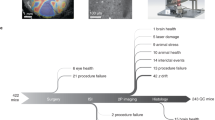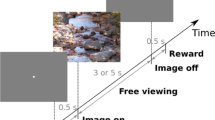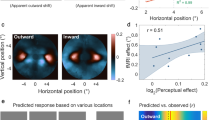Abstract
Visual attention can affect both neural activity and behavior in humans. To quantify possible links between the two, we measured activity in early visual cortex (V1, V2 and V3) during a challenging pattern-detection task. Activity was dominated by a large response that was independent of the presence or absence of the stimulus pattern. The measured activity quantitatively predicted the subject's pattern-detection performance: when activity was greater, the subject was more likely to correctly discern the presence or absence of the pattern. This stimulus-independent activity had several characteristics of visual attention, suggesting that attentional mechanisms modulate activity in early visual cortex, and that this attention-related activity strongly influences performance.
This is a preview of subscription content, access via your institution
Access options
Subscribe to this journal
Receive 12 print issues and online access
$209.00 per year
only $17.42 per issue
Buy this article
- Purchase on Springer Link
- Instant access to full article PDF
Prices may be subject to local taxes which are calculated during checkout







Similar content being viewed by others
References
Pashler, H. E. The Psychology of Attention (MIT Press, Cambridge, Massachusetts, 1998).
Posner, M. I., Snyder, C. R. & Davidson, B. J. Attention and detection of signals. J. Exp. Psychol. 109, 160–174 (1980).
Graham, N. Visual Pattern Analyzers (Oxford Univ. Press, New York, 1989).
Desimone, R. & Duncan, J. Neural mechanisms of selective visual attention. Annu. Rev. Neurosci. 18, 193– 222 (1995).
Martínez, A. et al. Involvement of striate and extrastriate visual cortical areas in spatial attention. Nat. Neurosci. 2, 364–369 (1999).
Chawla, D., Rees, G. & Friston, K.J. The physiological basis of attentional modulation in extrastriate visual areas. Nat. Neurosci. 2, 671– 676 (1999).
Brefczynski, J. A. & DeYoe, E. A. A physiological correlate of the ‘spotlight’ of visual attention. Nat. Neurosci. 2, 370–374 (1999).
Tootell, R. B. et al. The retinotopy of visual spatial attention. Neuron 21, 1409–1422 (1998).
Gandhi, S. P., Heeger, D. J. & Boynton, G. M. Spatial attention affects brain activity in human primary visual cortex. Proc. Natl. Acad. Sci. USA 96 , 3314–3319 (1999).
Kastner, S., Pinsk, M. A., De Weerd, P., Desimone, R. & Ungerleider, L. G. Increased activity in human visual cortex during directed attention in the absence of visual stimulation . Neuron 22, 751–761 (1999).
Hillyard, S. A., Vogel, E. K. & Luck, S. J. Sensory gain control (amplification) as a mechanism of selective attention: electrophysiological and neuroimaging evidence. Phil. Trans. R. Soc. Lond. B Biol. Sci. 353, 1257– 1270 (1998).
Reynolds, J. H., Chelazzi, L. & Desimone, R. Competitive mechanisms subserve attention in macaque areas V2 and V4. J. Neurosci. 19, 1736– 1753 (1999).
Luck, S. J., Chelazzi, L., Hillyard, S. A. & Desimone, R. Neural mechanisms of spatial selective attention in areas V1, V2, and V4 of macaque visual cortex J. Neurophysiol. 77, 24–42 (1997).
McAdams, C. J. & Maunsell, J. H. Effects of attention on the reliability of individual neurons in monkey visual cortex . Neuron 23, 765–773 (1999).
Colby, C. L., Duhamel, J. R. & Goldberg, M. E. Visual, presaccadic, and cognitive activation of single neurons in monkey lateral intraparietal area. J. Neurophysiol. 76, 2841–2852 (1996).
Motter, B. C. Focal attention produces spatially selective processing in visual cortical areas V1, V2, and V4 in the presence of competing stimuli. J. Neurophysiol. 70, 909–919 (1993).
Roelfsema, P. R., Lamme, V. A. & Spekreijse, H. Object-based attention in the primary visual cortex of the macaque monkey. Nature 395, 376– 381 (1998).
Haenny, P. E. & Schiller, P. H. State dependent activity in monkey visual cortex. I. Single cell activity in V1 and V4 on visual tasks . Exp. Brain Res. 69, 225– 244 (1988).
Haenny, P. E., Maunsell, J. H. & Schiller, P. H. State dependent activity in monkey visual cortex. II. Retinal and extraretinal factors in V4. Exp. Brain Res. 69, 245–259 (1988).
Spitzer, H., Desimone, R. & Moran, J. Increased attention enhances both behavioral and neuronal performance. Science 240, 338– 340 (1988).
Ogawa, S., Lee, T. M., Kay, A. R. & Tank, D. W. Brain magnetic resonance imaging with contrast dependent on blood oxygenation. Proc. Natl. Acad. Sci. USA 87, 9868– 9872 (1990).
Kwong, K. K. et al. Dynamic magnetic resonance imaging of human brain activity during primary sensory stimulation. Proc. Natl. Acad. Sci. USA 89, 5675–5679 (1992).
Ogawa, S. et al. Intrinsic signal changes accompanying sensory stimulation: functional brain mapping with magnetic resonance imaging. Proc. Natl. Acad. Sci. USA 89, 5951–5955 (1992).
Belliveau, J. W. et al. Functional mapping of the human visual cortex by magnetic resonance imaging. Science 254, 716– 719 (1991).
Malonek, D. & Grinvald, A. Interactions between electrical activity and cortical microcirculation revealed by imaging spectroscopy: implications for functional brain mapping. Science 272, 551–554 (1996).
Buxton, R. B., Wong, E. C. & Frank, L. R. Dynamics of blood flow and oxygenation changes during brain activation: the balloon model. Magn. Reson. Med. 39, 855–864 (1998).
Boynton, G. M., Engel, S. A., Glover, G. H. & Heeger, D. J. Linear systems analysis of functional magnetic resonance imaging in human V1. J. Neurosci. 16, 4207– 4221 (1996).
Tootell, R. B. et al. Functional analysis of human MT and related visual cortical areas using magnetic resonance imaging. J. Neurosci. 15, 3215–3230 (1995).
Boynton, G.M., Demb, J. B., Glover, G. H. & Heeger, D. J. Neural basis of contrast discrimination. Vision Res. 39, 257–269 (1999).
Carandini, M., Heeger, D. J. & Movshon, J. A. Linearity and normalization in simple cells of the macaque primary visual cortex. J. Neurosci. 17, 8621–8644 (1997).
Demb, J., Boynton, G. M. & Heeger, D. J. Functional magnetic resonance imaging of early visual pathways in dyslexia. J. Neurosci. 17, 8621 –8644 (1997).
Shulman, G. L. et al. Areas involved in encoding and applying directional expectations to moving objects. J. Neurosci. 19, 9480 –9496 (1999).
Heeger, D. J., Boynton, G. M., Demb, J. B., Seidemann, E. & Newsome, W. T. Motion opponency in visual cortex . J. Neurosci. 19, 7162– 7174 (1999).
Wandell, B. A. et al. Color signals in human motion-selective cortex. Neuron 24, 901–909 (1999).
Seidemann, E., Poirson, A. B., Wandell, B. A. & Newsome, W. T. Color signals in area MT of the macaque monkey. Neuron 24, 911–917 (1999).
Rees, G., Friston, K. & Koch, C. A direct quantitative relationship between the functional properties of human and macaque V5. Nat. Neurosci. 3, 716–723 (2000).
Heeger, D. J., Huk, A. C., Geisler, W. S. & Albrecht, D. G. Spikes versus BOLD: What does neuroimaging tell us about neuronal activity? Nat. Neurosci. 3, 631– 633 (2000).
Ito, M. & Gilbert, C. D. Attention modulates contextual influences in the primary visual cortex of alert monkeys. Neuron 22, 593–604 (1999).
Nestares, O. & Heeger, D. J. Robust multiresolution alignment of MRI brain volumes. Magn. Reson. Med. 43, 705–715 (2000).
Engel, S. A. et al. fMRI of human visual cortex. Nature 369, 525 (1994).
Engel, S. A., Glover, G. H. & Wandell, B. A. Retinotopic organization in human visual cortex and the spatial precision of functional MRI. Cereb. Cortex 7, 181–192 (1997).
Sereno, M. I. et al. Borders of multiple visual areas in humans revealed by functional magnetic resonance imaging. Science 268, 889–893 (1995).
DeYoe, E. A. et al. Mapping striate and extrastriate visual areas in human cerebral cortex. Proc. Natl. Acad. Sci. USA 93, 2382 –2386 (1996).
Glover, G. H. & Lai, S. Self-navigated spiral fMRI: interleaved versus single-shot. Magn. Reson. Med. 39, 361–368 (1998).
Glover, G. H. Simple analytic spiral K-space algorithm. Magn. Reson. Med. 42, 412–415 (1999).
Smith, A. M. et al. Investigation of low frequency drift in fMRI signal. Neuroimage 9, 526–533 (1999).
Aguirre, G. K., Zarahn, E. & D'Esposito, M. The variability of human, BOLD hemodynamic responses . Neuroimage 8, 360–369 (1998).
Green, D. M. & Swets, J. A. Signal Detection Theory and Psychophysics (Peninsula Publishing, Los Altos, California, 1988 ).
Efron, B. & Tibshirani, R. J. An Introduction to the Bootstrap (Chapman & Hall, New York, 1993).
Acknowledgements
We thank W.T. Newsome, B.A. Wandell and M. Carandini for comments. This research was supported by an NEI grant (R01-EY11794), a grant from the Human Frontier Science Program, and two NRSA postdoctoral research fellowships (F32-EY06899 and F32-EY06952).
Author information
Authors and Affiliations
Corresponding author
Rights and permissions
About this article
Cite this article
Ress, D., Backus, B. & Heeger, D. Activity in primary visual cortex predicts performance in a visual detection task. Nat Neurosci 3, 940–945 (2000). https://doi.org/10.1038/78856
Received:
Accepted:
Issue Date:
DOI: https://doi.org/10.1038/78856
This article is cited by
-
Representations in human primary visual cortex drift over time
Nature Communications (2023)
-
Subjective confidence reflects representation of Bayesian probability in cortex
Nature Human Behaviour (2022)
-
Evidence accumulation relates to perceptual consciousness and monitoring
Nature Communications (2021)
-
A flexible readout mechanism of human sensory representations
Nature Communications (2019)
-
Neural correlates of body comparison and weight estimation in weight-recovered anorexia nervosa: a functional magnetic resonance imaging study
BioPsychoSocial Medicine (2018)



